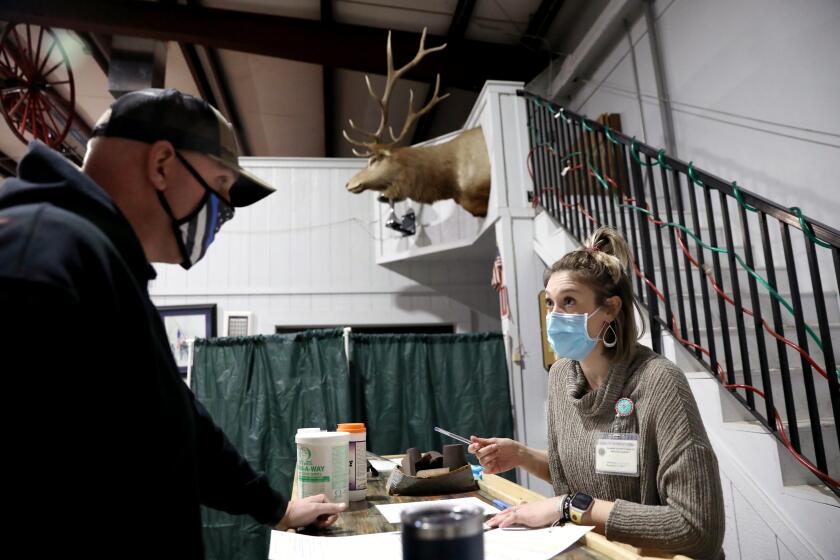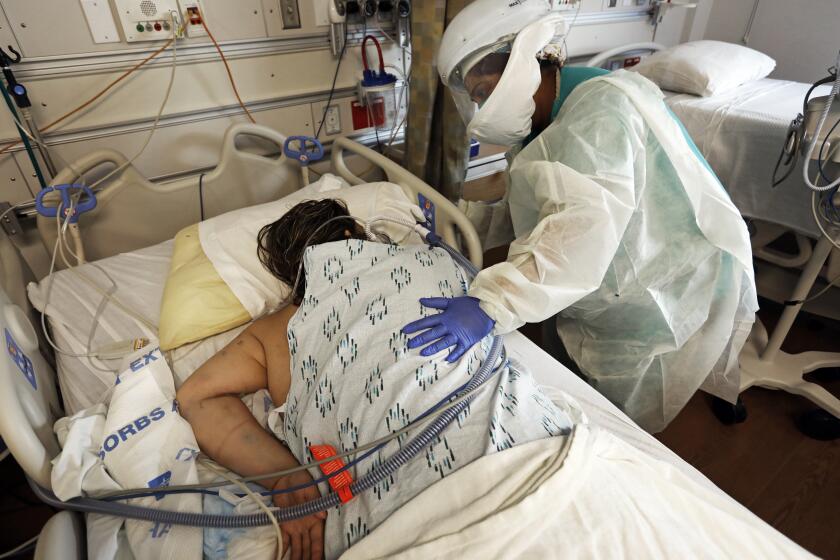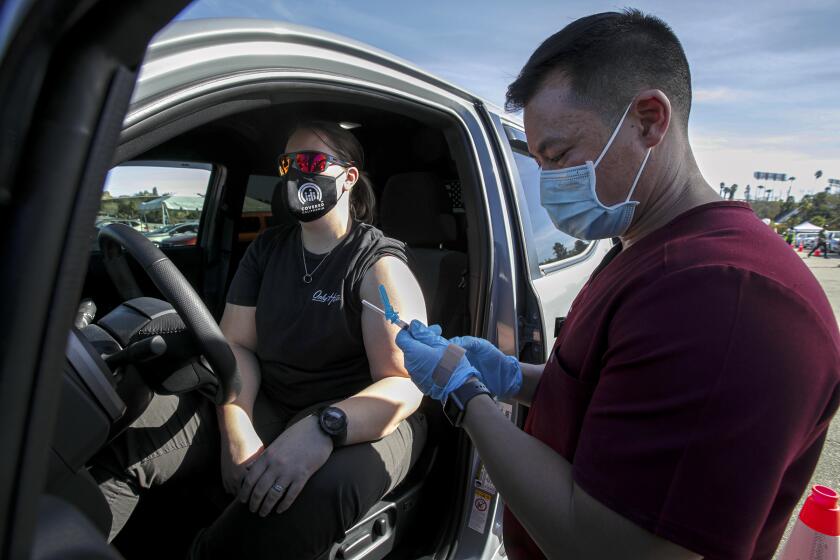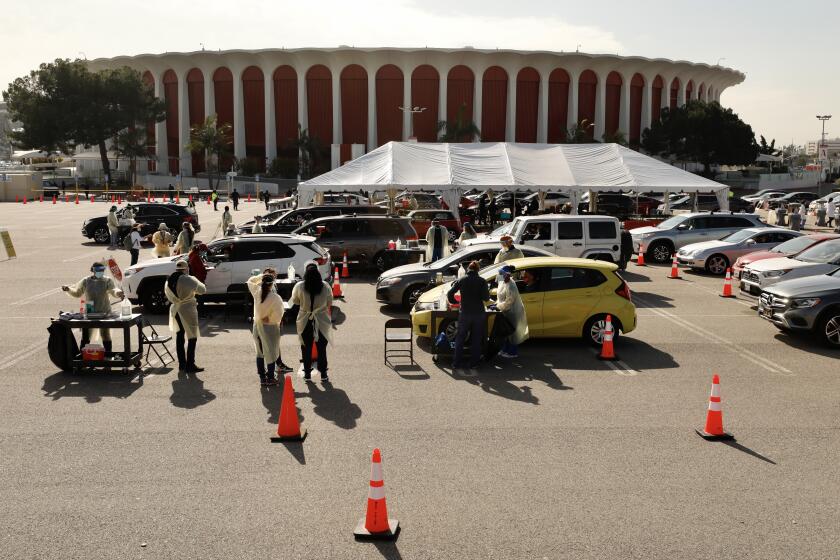California hits 3 million coronavirus cases; roughly 1 out of 13 in state have been infected
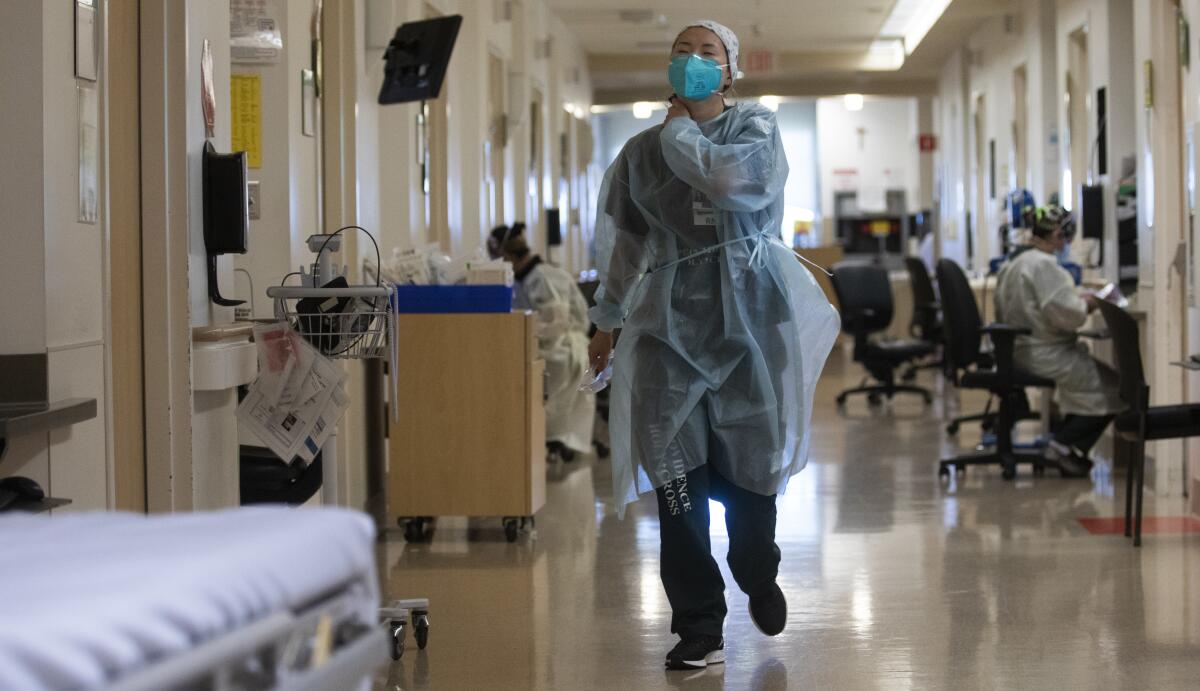
- Share via
California passed 3 million confirmed coronavirus cases Tuesday — a mind-boggling milestone that arrived amid promising signs that the pandemic has plateaued following a months-long surge, as well as fresh concerns that recently confirmed variants could add more fuel to the viral wildfire.
The 3-million case mark, established through a Times survey of county and city health departments, demonstrates how widely the coronavirus has spread throughout the nation’s most-populous state.
Clearing that threshold means roughly 1 out of every 13 Californians have tested positive at some point during the pandemic. But officials have long believed that testing captures only a certain percentage of those who are infected, because many with the virus have mild symptoms or none at all.
Even so, the growth in the documented case count has been meteoric. It took roughly 10 months for the state to reach 1 million confirmed cases, which happened in mid-November. California went on to hit 2 million cumulative infections shortly before Christmas.
Now, only about four weeks later, the state has added another million cases to its total.
Dr. Tomás Aragón, the state public health officer and director of the California Department of Public Health, called the case number “a serious reminder that COVID-19 is prevalent throughout California.” He added: “We all need to do our part by staying home; wearing a mask; avoiding gathering, especially indoors; frequent hand washing and getting vaccinated when eligible and available.
“While we are seeing some encouraging signs as hospitalizations and case rates are decreasing, California remains relentless in its commitment in the battle against COVID-19,” Aragón said. “We cannot become complacent because a vaccine is now available.”
The slope and scope of the pandemic’s latest wave makes California’s summertime surge look like a speed bump.
Back then, the highest number of daily reported infections topped out at roughly 13,000 statewide. Over the last week, California has averaged nearly 36,000 new cases a day, according to data compiled by The Times.
As astonishing as that rate is, it’s actually tumbled a bit. It wasn’t long ago that the state was seeing nearly 45,000 cases a day.
While the latest numbers are probably influenced somewhat by delays in testing or data reporting over the Martin Luther King Jr. Day weekend, they are further evidence that the coronavirus has leveled off — and that California may have avoided the kind of apocalyptic post-Christmas surge that officials had warned could overwhelm the state’s healthcare system.
California has also seen a flattening, and even a slight decline, in the number of people requiring hospitalization for COVID-19. There were 20,062 coronavirus-positive Californians hospitalized as of Monday, which is a nearly 8% decline from a week ago, according to the latest state data.
The number of people ill enough to require intensive care has also dipped, to 4,693 as of Monday. That’s down 3% from the previous week.
Though slight, any declines come as welcome news to California’s beleaguered hospitals and healthcare workers, who have had to contend with sharp and sustained increases in the number of COVID-19 patients since early November.
“These are rays of hope shining through,” said Dr. Mark Ghaly, California’s health and human services secretary.
Many ICUs throughout the state remain stressed, however — particularly in Southern California and the San Joaquin Valley, which have both reported 0% availability in their intensive care units for weeks. That doesn’t mean no beds are open but that hospitals have had to take significant, even drastic, steps to care for the sickest patients.
But declines in the daily case rate, as well as in the percentage of people being tested who are found to be infected, hopefully foreshadow a corresponding dip in the number of COVID-19 patients needing to go to the hospital, Ghaly said Tuesday. Another promising data point, he added, is that the modeled statewide rate of transmission, or R-effective, has now dipped below 1 — meaning those who test positive are, on average, going on to infect fewer than one other person.
When the R-effective is below 1, case counts will gradually decrease.
“The good news is that ... the spread of COVID is not growing in the state, but decreasing — just a little more slowly than we would like,” Ghaly said.
In rural Northern California, small public health departments battle COVID-19 in a region where skepticism of the virus runs deep.
Officials warn that the recent progress is fragile — and that the stakes remain high. Nearly 34,000 Californians have died from COVID-19, and vaccine supplies are still not adequate. In most of Los Angeles County, people 65 and older have not been vaccinated, despite an announcement from Gov. Gavin Newsom last week that they were eligible.
“We are closer and closer to ending this pandemic, and collective action is what makes the difference in how many more people die,” L.A. County Public Health Director Barbara Ferrer said in a statement Monday.
That’s particularly the case as California grapples with the presence of new variants of the coronavirus, including one — known as B.1.1.7 — that was first identified in Britain, and which scientists believe is even more contagious.
Because of its potential to spread quickly, modeling indicates that this variant “has the potential to increase the U.S. pandemic trajectory in the coming months” and could become “the predominant variant in March,” according to a recent report from the U.S. Centers for Disease Control and Prevention.
Another new coronavirus strain — dubbed CAL.20C — could have contributed to the significant winter surge seen throughout Southern California, according to recent research published by Cedars-Sinai.
Researchers said in a statement that the strain “was almost nonexistent in October,” but “by December, 36.4% of virus samples from Cedars-Sinai patients were determined to be the strain, as were 24% of all samples from Southern California.”
“The recent surge in COVID-19 positive cases in Southern California coincides with the emergence of CAL.20C,” said Dr. Eric Vail, director of molecular pathology in the Department of Pathology and Laboratory Medicine at Cedars-Sinai.
Another coronavirus variant, designated L452R, has also circulated in the state and been identified in several large outbreaks in Santa Clara County — including one that has infected dozens of staff members and 15 patients at Kaiser’s San Jose Medical Center.
All coronavirus mutations pose a risk of changing viral behavior in potentially adverse ways, Ghaly said. The state and its partners are still figuring out how broadly L452R has spread across California, as well as the specifics on what the variant will mean, if anything, “in terms of infectiousness and impact on things like virulence, how severe the disease is, and if there’s any implications on the efficacy, effectiveness of vaccines,” he said.
“These variants just underscore the need to continue to keep our guard up — that, if we do see variations in how infectious this strain of the virus is versus the one that we’ve been dealing with for many, many months now, it will certainly impact how we can move forward,” he said.
As the number of coronavirus infections in California approaches 3 million, health officials said Sunday that a new strain — different from a highly contagious variant first identified in the U.K. — is popping up across the state.
Viral mutations are not unexpected and, in many cases, don’t end up making much of a difference, according to Dr. Anthony Fauci, the U.S. government’s top infectious diseases expert.
“When you have a lot of virus that’s circulating in the community, it means it’s infecting a lot of people, it’s replicating a lot. And, when you replicate, you mutate,” he said during a virtual conversation with Newsom late last month. “The overwhelming majority of mutations are irrelevant. They don’t have any impact on any important function of the virus.”
But, he added, “every once in a while, you get a mutation that does” — as appears to be the case with the U.K. variant. Even so, scientists believe that variant isn’t more likely to be fatal or make people sicker once they are infected, and there’s also no evidence that the newly developed vaccines won’t be effective against it.
Southern California is speeding up rollout of the COVID-19 vaccine. This is where counties stand on their distribution plans.
But given the continued infection risk, as well as the relative scarcity of vaccines at this point, health officials emphasize that the best way to tamp down transmission is through adherence to the oft-recited infection prevention protocols — such as wearing masks in public, avoiding gatherings with those outside your household, regularly washing your hands and staying home when you’re sick.
Some L.A. County officials intimated last week that they were considering potential new business restrictions to further stem the spread of the coronavirus.
No additional measures have been unveiled, though county Supervisor Hilda Solis said Tuesday that “we’re looking at all the tools that are available.”
“We still know that there are many, for example, businesses that may not be in full compliance and big industries that have several hundred employees that work for them,” she said during a briefing. “We would like to see them comply more, and we have tools available to do that. But at this point I think we are all very, very mindful of what we have to do to continue to stop the spread of this new variant that we know is here.”
Though the rollout of COVID-19 vaccines is understandably cause for celebration, officials continue to warn that there aren’t enough available doses to give a shot to everyone who wants one.
Shortages will limit how many older L.A. County residents will be able to get the vaccine in the coming weeks.
San Francisco’s public health department will run out of COVID-19 vaccine Thursday because the city’s allocation dropped substantially from a week ago and doses that had to be discarded were not replaced, officials said Tuesday.
In L.A. County, residents 65 and older can now schedule appointments to receive the vaccine, but officials said limited supply will slow how many older Angelenos can get the shots.
“It’s always hard when you’re operating in scarcity, but I do appreciate the need for us to be mindful of moving forward as quickly as we can to get those at high risk [vaccinated], and I think that’s what this strategy allows us to do,” Ferrer said Tuesday.
Times staff writers Jaclyn Cosgrove and Maura Dolan contributed to this report.
More vaccine information:
Those 65 and older in L.A. County can sign up for an appointment at the county public health department’s website, vaccinatelacounty.com. Residents without computer access can call (833) 540-0473 between 8 a.m. and 8:30 p.m. for assistance with reservations.
The City of Los Angeles is also offering the vaccine to anyone in Los Angeles County who is 65 and older, through a different online portal, https://carbonhealth.com/covid-19-vaccines. That website connects patients to sites including Dodger Stadium, San Fernando Recreation Park, Lincoln Park, Hansen Dam and Crenshaw Christian Center.
More to Read
Sign up for Essential California
The most important California stories and recommendations in your inbox every morning.
You may occasionally receive promotional content from the Los Angeles Times.
